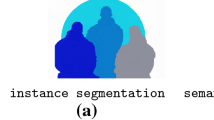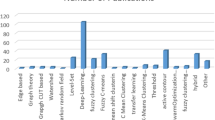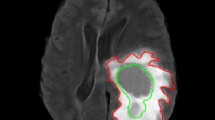Abstract
Image analysis techniques have been broadly used in computer-aided medical analysis and diagnosis in recent years. Computer-aided image analysis is an increasingly popular tool in medical research and practice, especially with the increase of medical images in modality, amount, size, and dimension. Image segmentation, a process that aims at identifying and separating regions of interests from an image, is crucial in many medical applications such as localizing pathological regions, providing objective quantative assessment and monitoring of the onset and progression of the diseases,as well as analysis of anatomical structures.
Access this chapter
Tax calculation will be finalised at checkout
Purchases are for personal use only
Preview
Unable to display preview. Download preview PDF.
Similar content being viewed by others
Bibliography
Pham, D. L., Xu, C. J., and Prince, L., A survey of current methods in medical image segmentation, Ann. Rev. Biomed. Eng., Jan 1998.
Haralick, R. M. and Shapiro, L. G., Image segmentation techniques, Comput. Vision, Graphics Image Process., Vol. 29, No. 1, pp. 100–132, 1985.
Fu, K. S. and Mui, J. K. A survey on image segmentation, Patt. Recogn., Vol. 13, pp. 3–16, 1981.
Pal, N. R. and Pal, S. K., A review on image segmentation techniques, Patt. Recogn., Vol. 26, No. 9, pp. 1277–1294, 1993.
Suri, J. S., Setarehdan, S. K., and Singh, S., eds., Advanced Algorithmic Approaches to Medical Image Segmentation, Springer-Verlag, London, 2002.
Skarbek, W. and Koschan, A., Colour image segmentation: A survey, Technical Report 94-32, Technical University, Berlin, 1994.
Lucchese, L. and Mitra, S. K., Color image segmentation: A state-of-the-art survey, Proc. Indian Nat. Sci. Acad. (INSA-A), Vol. 67, No. 2, pp. 207–221, 2001.
Bezdek, J. C., Hall, L. O., and Clarke, L. P., Review of MR image segmentation techniques using pattern recognition, Med. Phys., Vol. 20, pp. 1033–1048, 1993.
Clarke, L.P., Camacho, R.P., Velthuizen, M. A., Heine, J. J., Vaidyanathan, M., Hall, L. O., Thatcher, R. W., and Silbiger, M. L., Review of MRI segmentation: Methods and applications, Magn. Reso. Imaging, Vol. 13, No. 3, pp. 343–368, 1995.
Zadeh, L. A., Fuzzy sets, Inf. Control Theory, Vol. 8, pp. 338–353, 1965.
Zadeh, L. A., Outline of a new approach to the analysis of complex systems and decision processes, IEEE Trans. Syst., Man, Cybern., Vol. SMC-3, pp. 28–44, 1973.
Jain, A. K., Murty, M. N., and Flynn, P. J. Data clustering: A review, ACM Comput Surveys, Vol. 31, No. 3, pp. 264–323, 1999.
Rose, K. Deterministic annealing for clustering, compression, classification, regression, and related optimization problems, Proc. IEEE, Vol. 86, No. 11, 1998.
Newton, S. C., Pemmaraju, S., and Mitra, S., Adaptive fuzzy leader clustering of complex data sets in pattern recognition, IEEE Trans. Neural Networks, Vol. 3, pp. 794–800, 1992.
MacQueen, J., Some methods of classification and analysis of multivariate observations, In: Proceedings of 5th Berkeley Symposium on Math., Stat., and Prob., LeCam, L. M. and Neyman, J., eds., University of California Press, Berkeley, CA, pp. 281, 1967.
Bezdek, J., Pattern Recognition with Fuzzy Objective Function Algorithms, Plenum Press, New York, 1981.
Gonzalez, R. C. and Woods, R. E., Digital Image Processing, Addison Wesley, Reading, MA, 1992.
Marroquin, J. L. and Girosi, F., Some extensions of the k-means algorithm for image segmentation and pattern recognition, Technical Report, MIT AI Lab., AI Memo 1390, Jan 1993.
Fraley, C. and Raftery, A. E., How many clusters? Which clustering method? Answers via model-based cluster analysis, Technical Report No. 329, University of Washington, 1998.
Ray, S., Turi, R. H., and Tischer, P. E., Clustering-based color image segmentation: An evaluation study, In: Proceedings of Digital Image Computing: Techniques and Applications, Brishbane, Qld., Austrlia, 6–8 Dec. 1995, pp. 86–92.
Park, S. H., Yun, I. D., and Lee, S. U., Color image segmentation based on 3-D clustering: Morphological approach, Patt. Recogn., Vol. 31, No. 8, pp. 1061–1076, 1998.
Weeks, A. R., and Hague, G. E., Color segmentation in the HIS color space using the k-means algorithm, In: Proceedings of the SPIE—Nonlinear Image Processing VIII, San Jose, CA, Feb, 10–11, 1997, pp. 143–154.
Wu, J., Yan, H., and Chalmers, A. N., Color image segmentation using fuzzy clustering and supervised learning, J. Electron. Imaging, pp. 397–403, 1994.
Pappas, T. N., An adaptive clustering algorithm for image segmentation, IEEE Trans. Signal Process., Vol. SP-40, pp. 901–914, 1992.
Schmid, P., Segmentation of digitized dermatoscopic images by two-dimensional color clustering, IEEE Trans. Med. Imaging, Vol. MI-18, No. 2, pp. 164–171, 1999.
Carpenter, G. A. and Grossberg, S., A massively parallel architecture for a self-organizing neural pattern recognition machine, Comput Vision, Graphics Image Process., Vol. 37, pp. 54–115, 1987.
Carpenter, G. and Grossberg, S. Art-2: Self organization of stable category recognition codes for analog input patterns, Appl. Opt., Vol. 26, pp. 4919–4930, 1987.
Carpenter, G. and S. Grossberg, Art-3: Hierarchical search using chemical transmitters in self-organizing pattern recognition architectures, Neural Networks, Vol. 3, pp. 129–152, 1990.
Grossberg, S., Embedding fields: A theory of learning with physiological implications, J. Math. Psychol., Vol. 6, pp. 209–239, 1969.
Rumelhart D. E. and Hipser, D., Feature discovery by competitive learning, In: Parallel Distributed Processing, MIT Press, Cambridge, MA, pp. 151–193, 1986.
Mitra, S. and Yang, S. Y., High fidelity adaptive vector quantization at very low bit rates for progressive transmission of radiographic images, J. Electron Imaging, Vol. 11, No. 4(Suppl. 2), pp. 24–30, 1998.
Mitra, S., Castellanos, R., Yang, S. Y., and Pemmaraju, S., Adaptive clustering for image segmentation and vector quantization, In: Soft-Computing for Image Processing, Editors: Pal, S. K., Ghosh, A., and Kundu, M. K., eds., Springer-Verlag, New York, 1999.
Kirkpatrick, S., Gelatt, C. D., and Vecchi, M. P., Optimization by simulated annealing, Science, Vol. 220, pp. 671–680, 1983.
Metropolis, N., Rosenbluth, A. W., Rosenbluth, M. N., Teller, A. H., and Teller, E., Equations of state calculations by fast computing machines, J. Chem. Phys., Vol. 21, No. 6, pp. 1087–1091, 1953.
Johnston, B., Atkins, M. S., Mackiewich, B., and Anderson, M., Segmentation of multiple sclerosis lesions in intensity corrected multispectral MRI, IEEE Trans. Med. Imaging, Vol. 15, pp. 154–169, 1996.
Zijdenbos, A. P., Dawant, B. M., Margolin, R. A., and Palmer, A. C., Morphometric analysis of white matter lesions in MR images: Method and validation, IEEE Trans. Med. Imaging, Vol. 13, No. 4, pp. 716–724, 1994.
Hall, L. O., Bensaid, A. M., Clarke, L. P., Velthuizen, R. P., Silbiger, M. S., and Bezdek, J. C., A comparison of neural network and fuzzy clustering techniques in segmenting magnetic resonance images of the brain, IEEE Trans. Neural Networks, Vol. 35, pp. 672–682, 1992.
Clark, M. C., Hall, L. O., Goldgof, D. B., et al., MRI segmentation using fuzzy clustering-techniques, IEEE Eng. Med. Biol., Vol. 13, No. 5, pp. 730–742, 1994.
Kamber, M., Collins, D. L., Shinghal, R., Francis, G. S., and Evans, A. C., Model-based 3-D segmentation of multiple sclerosis lesions in dual-echo MRI data, Proc. SPIE Visual. Biomed. Comput., Vol. 1808, pp. 590–600, 1992.
Jackson, E. F., Narayana, P. A., Wolinsky, J. S., and Doyle, T. J., Accuracy and reproducibility in volumetric analysis of multiple sclerosis lesions, J. Comut. Assisted Tomog., Vol. 17, No. 2, pp. 200–205, 1993.
Kapouleas, I., Automatic detection of white matter lesions in magnetic resonance brain images, Comput. Methods Programs Biomed., Vol. 32, pp. 17–35, 1990.
Mitchell, J. R., Karlik, S. J., Lee, D. H., and Fenster, A., Automated detection and quantification of multiple sclerosis lesions in MR volumes of the brain, Proc. SPIE Med. Imag. VI: Image Process., Vol. 1652, pp. 99–106, 1992.
Johnston, B. G., Atkins, M. S., and Booth, K. S., Partial volume segmentation in 3-D of lesions and tissues in magnetic resonance images, Proc. SPIE Med. Imaging, Vol. 2167, pp. 28–39, 1994.
Gerig, G., Kübler, O., Kikinis, R., and Jolesz, F. A., Nonlinear anisotropic filtering of MRI data, IEEE Trans. Med. Imaging, Vol. 11, pp. 221–232, 1992.
Leemput, K. V., Maes, F., Vandermeulen, D., Colchester, A., and Suetens, P., Automated segmentation of multiple sclerosis lesions by model outlier detection, IEEE Trans. Med. Imaging, Vol. 20, No. 8, pp. 677–688, 2001.
Kwan, R. K.-S., Evans, A. C., and Pike, G. B., MRI simulation-based evaluation of image-processing and classification methods, IEEE Trans. Med. Imaging. Vol. 18, No. 11, pp. 1085–97, 1999.
Cocosco, C. A., Kollokian, V., Kwan, R. K.-S., and Evans, A. C., Brain Web: Online Interface to a 3D MRI Simulated Brain Database, available at: http://www.bic.mni.mcgill.ca/brainweb/.
Corona, E., Mitra, S., Wilson, M., and Soliz, P., Digital stereo optic disc image analyzer for monitoring progression of glaucoma, Proc. SPIE, Vol. 4684, pp. 82–93, 2002.
Corona, E., Mitra, S., Wilson, M., Krile, T., Kwon, Y. H., and Soliz, P., Digital stereo image analyzer for generating automated 3-D measures of optic disc deformation in glaucoma, IEEE Trans. Med. Imaging, Vol. 2, No. 10, pp. 1244–1253, 2002.
Yang, S., King, P., Corona, E., Wilson, M., Aydin, K., Mitra, S., Soliz, P., Nutter, B., and Kwon, Y. H., Feature extraction and segmentation in medical images by statistical optimization and point operation approaches, Proc. SPIE, Vol. 5032, pp. 1676–1684, 2003.
Mitra, S., Nutter, B. S., and Krile, T. F., Automated method for fundus image registration and analysis, Appl. Optics, Vol. 27, pp. 1107–1112, 1988.
Lee, D. J., Krile, T. F., and Mitra, S., Power cepstrum and spectrum techniques applied to image registration, Appl. Optics, Vol. 27, pp. 1099–1106, 1988.
Sun, C., A fast stereo matching method, In: Proceedings of Digital Image Computing: Techniques and Applications, Massey University, Auckland, New Zeland, December 10–12, 1997, pp. 95–100.
Ramirez, J., Mitra, S., and Morales, J., Visualization of the three dimensional topography of the optic nerve head through a passive stereo vision model, J. Electron. Imaging, Vol. 8, No. 1, pp. 92–97, 1999.
Smith, P.W. and Nandhakumar, N., An improved power cepstrum based stereo correspondence method for textured scenes, IEEE Trans. Patt. Anal. Machine Intell., Vol. 18, No. 3, pp. 338–348, Mar. 1996.
Pratt, W. K., Digital Image Processing, 2nd edn., Wiley-Interscience, New York, pp. 112–117, 1991.
Kirbas, C. and Quek, F. K. H., Vessel extraction techniques and algorithms: A survey, In: 3rd Symposium on Bioinfomatics and BioEngineering, Bethesda, Maryland, March 2003, pp. 238–245.
Kass, M., Witkin, A., and Terzoopoulos, D., Snakes: Active contour models, Int. J. Comp. Vision, Vol. 1, pp. 321–331, 1988.
Osher, S. and Sethian, J. A., Fronts propagating with curvature dependent speed: Algorithms based on hamilton-jacobi formulation, JCP, Vol. 79, pp. 12–49, 1988.
Chaudhuri, S. C., Katz, N., Nelson, M., and Goldbaum, M., Detection of blood vessels in retinal images using two dimensional blood vessel filters, IEEE Trans. Med. Imaging, Vol. 8, pp. 263–269, 1989.
Wood, S. L., Qu, G., and Roloff, L. W., Detection and labeling of retinal vessels for longitudinal studies, In: IEEE International Conference on Image Processing, 1995, Vol. 3, pp. 164–167.
Hoover, A., Kouznetsova, V., and Goldbaum, M., Locating blood vessels in retinal images by piecewise threshold probing of a matched filter response, IEEE Trans. Med. Imaging, Vol. 19, pp. 203–210, 2000.
Zana, F. and Klein, J. C., Robust segmentation of vessels from retinal angiography, in IEEE International Conference on Digital Signal Processing, 1997, Vol. 2, pp. 1087–1090.
Tolias, Y. and Panas, S. M., A fuzzy vessel tracking algorithm for retinal images based on fuzzy clustering, IEEE Trans. Med. Imaging, Vol. 17, pp. 263–273, 1998.
Zhou, L., Rzeszotarski, M. S., Singerman, L. J., and Chokreff, J. M., The detection and quantification of retinopathy using digital angiograms, IEEE Trans. Med. Imaging, Vol. 13, pp. 619–626, 1994.
Rosenfeld, A., On connectivity properties of grayscale pictures, Patt. Recogn., Vol. 16, No. 1, pp. 47–50, 1983.
Wang, W., Sun, C., and Chao, H., Color image segmentation and understanding through connected components, In: Proceedings of 1997 IEEE Int’l Conf. on Systems, Man, and Cybernetics, Orlando, FL, Oct. 12–15, 1997, Vol. 2, pp. 1089–1093.
Castellanos, R., Castillo, H., and Mitra, S., Performance of nonlinear methods in medical image restoration, SPIE Proc. Nonlinear Image Process., Vol. 3646, 1999.
Jain, A. K. and Dubes, R. C., Algorithms for Clustering Data, Prentice Hall, Englewood Cliffs, NJ, 1988.
Johnson, K. A., and Becker, J. A. The Whole Brain Atlas, available at: http://www.med.harvard.edu/AANLIB/.
Author information
Authors and Affiliations
Editor information
Editors and Affiliations
Rights and permissions
Copyright information
© 2005 Kluwer Academic/Plenum Publishers, New York
About this chapter
Cite this chapter
Yang, S., Mitra, S. (2005). Statistical and Adaptive Approaches for Optimal Segmentation in Medical Images. In: Suri, J.S., Wilson, D.L., Laxminarayan, S. (eds) Handbook of Biomedical Image Analysis. Topics in Biomedical Engineering International Book Series. Springer, Boston, MA. https://doi.org/10.1007/0-306-48606-7_6
Download citation
DOI: https://doi.org/10.1007/0-306-48606-7_6
Publisher Name: Springer, Boston, MA
Print ISBN: 978-0-306-48605-0
Online ISBN: 978-0-306-48606-7
eBook Packages: EngineeringEngineering (R0)




